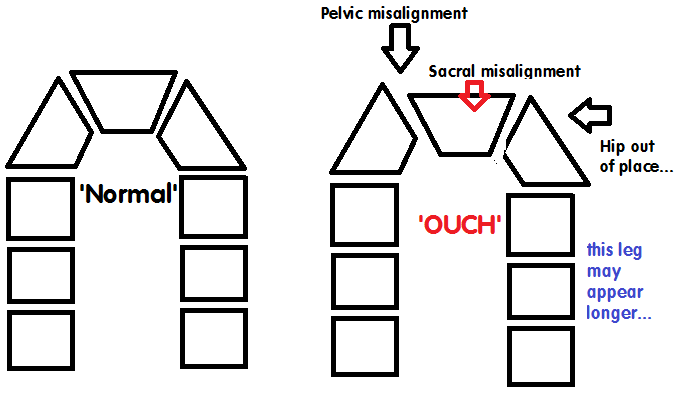The Sacro-iliac Joint. A real pain in the ass.
Above is an X-ray of a pretty much normal pelvis. There are some basic misalignment issues and some arthritic changes there but let’s use it as our study example.
The main thing I want to focus on is the sacro iliac joint. That is the connector of your pelvic bones to the base of the spine, the sacrum. The sacrum is a pizza-piece shaped bone, pointing down. At the bottom of the sacrum is the tail bone, called the coccyx.

I also drew a diagram of a very basic pelvis to see how it kinda fits together. The diagram above is that of an arch, like in a doorway made of stone. Notice how similar the structure is to the pelvis and lower body. The sides of the doorway are like the legs, the key stone at the top is like the sacrum.
When a misalignment occurs, and they can occur for many reasons, such as; muscle fatigue, injury (slow or fast like a fall or sitting in a position for a long time) or even emotional stress. The entire orientation of each part changes to try and maintain balance in the system. This causes compensations such as muscles tightening to help or splint the area, leg length changes to accommodate the shift in the direction of the pelvis or sacrum, or re-alignment of the entire spine up to the head to adapt to the problem.
Generally, when the sacrum becomes mis-aligned the pelvis rotates and shifts, or there may be a failure of the joint and you will have lots of pain. This pain causes spasm of some muscles and total loss of tone in others. This can make it hard or even impossible to get out of a chair or your car.
REPORT THIS AD
The sacrum meets the pelvis bones at the sacro-iliac joint. You can feel the bones of the ilium (top part of the pelvis) just below your belt line, on the back about 2″ from the center of the spine (that would be at about the sacrum). When I am confirming the alignment of the pelvis as related to leg length, that is what I use. One of the sides is likely to be tender to pressure.
OK, so what.
This is one of the main contributors of severe back pain. It can mimic and even confuse the most experienced practitioner (Medical Doctor, Physical Therapist, or Massage therapist) into thinking it is a disc injury. However, once you find this kind of mis-alignment and get it to move, the pain and spasm go away. This would not happen with a disc. (usually)… The sacro-iliac joint is fibrous, it is tough, in some books it is called immovable. But I assure you it moves! It can shift and slide out of place, even a millimeter can cause severe pain. It tends to move slowly, and responds better to slower adjustments with pelvic blocks.
On the right side of the arch diagram you can see where there is an arrow pointing to the pelvic misalignment. That is where the pain most likely would be felt. That space can be swollen or compressed. The muscles up the back and around the rump will spasm to try and splint it in place. It really has no idea if it is broken or not, just knows it is not where it should be and will try and stabilize it as best it can.
Typical symptoms of this kind of alignment problem is pain with movement, especially getting out of bed, changing positions in bed, getting out of a car, or in one, and a feel like it just may ‘give out’ on you with certain movements. Generally it feels like a ‘tooth ache’ feel at the sacroiliac joint or sometimes like an ice pick is stuck between the bones. This can give you shooting sharp pain. Usually it does not go down the leg like in sciatica. But it will be really focal and sharp. The muscles around it, the rump, front of thigh, and even muscles on the side of the hip can tighten. Also my favorite muscle the Psoas can spasm, giving you that bent over Quasimodo look.
So, how does it happen? Well, commonly it is because of a lifting issue a couple days before the pain showed up. It can be from sitting in an odd position like when you lie on the couch and watch a movie marathon or sat in a car for a long time on a road trip. Occasionally it is from stepping off a curve wrong or a slip and fall. Other ways it occurs, especially if the main part is the sacrum, could be from some congenital (an anomaly you were born with) malformation. In the furthest esoteric reasons, it could be from emotional instability related to foundation issues like home, career, stability, family etc…
That is why it is important to look at all of the areas of possible cause; physical, chemical, and emotional before starting to go into some treatment plan. Although it is difficult to pin down an emotional relationship, it is always a good idea to use it as an object of contemplation when going after a cause. Many times there are insights into the reasons which really do speed up the healing and normalizing process.
The therapies I use are pelvic blocking, heat, muscle stimulation and other chiropractic adjustments and realignment techniques. I also prescribe and teach stretching and other self care tricks of the trade to keep you ‘in the saddle’ as it were.
I had this very misalignment over 30 years ago when I was taking Japanese Jujitsu. I had done a terrible barrel roll fall and really messed up my back. The instructors there told me to do some exercises which, unfortunately made it worse. I went to my doctor (Medical doctor) and immediately they referred me for x-rays and within a week I was being scheduled for back surgery. Terrified, but in pain, I purposefully missed the appointment for the surgery and figured I would just be a cripple. Someone told me to go to a chiropractor. My father advised me not to because they were ‘quacks’ and would probably paralyze me. Well, once I became so disabled I could not manage stairs or put a pair of underwear on without sitting on the floor, I went to the chiropractor. I am not going to say there was any miracle, the treatment was painful at first and I was afraid. I followed the recommendations at the time, (daily for like ten days, then three times a week for a couple months, then twice a week, eventually getting down to about once a month.) I don’t use such schedules with my patients now (oh, did I mention I BECAME A CHIROPRACTOR!?) I have found that with as little as four or five visits we can get the same result as 15 visits too close together. It was the style at the time to have such an extensive treatment schedule, largely because my insurance paid. LOL…
REPORT THIS AD
Now I work on getting people out of pain, then getting them stable and show them how to care for it themselves so that they do not have to come in as often. Since I started practice I have had to send about five patients to surgery, but that is by far the exception to the rule with proper diagnosis and care.
Now, I use acupuncture, dry needling, chiropractic alignments, and stretching to help it get back in place and stay there. Most patients will need follow up care, depending on how well we did initially and how they care for their backs and what kind of activities they want to stick with. As for me, once I stabilized and strengthened I was able to do anything, including be an EMT in a major metro area, scuba dive all over the world, hike, bike, take more martial arts, and do pretty much what ever I wanted. I know that would have not been possible if I got surgery. Many surgeries fail, causing lasting problems and disability. The surgery can even kill you. I did not want to take that chance, and I was fine.
This kind of treatment is not for everyone, sometimes surgery IS the best choice. Sometimes all it takes is time and a little stretching, sometimes a swim will help reset it. Many times, a change in life situations can make a big difference. For me, I was really worried about what I wanted to do with my life at the time. I was getting student loans up the wazoo and had no plan. It was not for almost ten years I decided to become a chiropractor, it took another ten to do acupuncture training.
If you find yourself in this predicament, go see a reasonable chiropractor. Preferably one that does not get you on too much of a schedule. Contact me if you want more information. See my website http://www.thenaturalbodyworks.com or check out my YouTube Channel… thenaturalbodyworks. I can also be reached at my office by phone or text. 720- 325 then 9886 (don’t want a bunch of bots calling me) I can advise you and help you where I can.
Hope this helped.
Dr. Sean H. Thompson, B.Sc., D.C., CCAP etc…
Dr. Sean H. Thompson, B.Sc., D.C., CCAP etc…

























